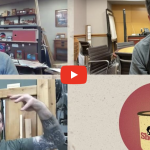We may receive a commission when you use our affiliate links. However, this does not impact our recommendations.

This hand surgeon likes meeting fellow woodworkers – but not at work.
I long ago lost track of how many people, upon learning of my interest in woodworking, have puzzled aloud over my table saw. They follow up with, “Do you know how important your hands are?” or, “Do you know how dangerous that thing can be?” The answers are, “Yes,” and “Absolutely.”
I’ve spent my entire professional career as a hand surgeon and have seen more woodworking injuries than probably anyone else (except for my hand-surgeon colleagues – many of whom are woodworkers). I’ve grown to respect the power of the machines we use, their ability to wreak havoc in an instant and our own inability to turn back time. I’ve seen injuries ranging from hyperaggressive manicures (“warning shots”) to life-changing amputations. This hasn’t at all diminished my enthusiasm for woodworking, but has given me insight into what causes injuries and how we can stay safe.
Many woodworking risks can be minimized by good practices such as keeping an uncluttered workshop, wearing masks, eye and ear protection, using dust collection and disposing of rags and chemicals correctly. And injuries happen with hand tools too – I’ve treated tendon and nerve injuries caused by errant paring chisels.
I’ve noticed that woodworking injuries tend to fall into a few categories.
Inattention: Repetition, fatigue, deadlines and complacency with a tool or technique are all setups for disaster. Tool work is no way to cool down from a bad day – if you can’t get a problem out of your head, stay away from the sharp stuff. I use that time to draw, clean the shop, read or search the internet for more tools, plans and tips.
Inadequate protection: In the hundreds of table saw injuries I’ve seen, I’ve yet to see an amputation from a table saw with an appropriate blade guard and splitter. There have never been many good reasons to remove the guard; now with better-designed saws, guards and riving knives, there are even fewer. I’ve seen woodworkers injured on the “backstroke” as they bring a hand back over an unprotected blade after a cut, those who didn’t see the teeth as the blade slowed and some who just pushed their hands into the blade as the work lifted, fluttered or started to kick. It is gruesome – use your guard.
Improper tool or setup: Nipping a little bit off a small piece on a table saw without a fence or guard? Ripping an 8′ board without adequate outfeed support? Holding a metal trim piece on the drill press with your hand? Sometimes the setup takes longer than the cut – featherboards, push sticks, guards and outfeed support all take time to position. That is time well spent.
Inexperience (or too much experience): Carefully consider all information you encounter on the internet – if an idea or technique doesn’t look safe, it probably isn’t. Read comments on videos, and note the source’s experience. Novice errors such as wrong-way feeding (inadvertently climb-cutting on the router table, for example) or jointing a too-short or too-thin piece are not uncommon. And those with “too much experience” often tout the acceptability of unsafe procedures. “I know it doesn’t look safe, but I’ve done it this way for years,” is a line heard too frequently in the emergency room.
Impairment: This should go without saying, but don’t drink and cut.
My hand-surgeon hands are valuable, but no more than anyone else’s. We all need hands to do our jobs and hobbies, write our names and hug our families. Protect yours and be safe. –David Shapiro
Here are some supplies and tools we find essential in our everyday work around the shop. We may receive a commission from sales referred by our links; however, we have carefully selected these products for their usefulness and quality.









I yet to see guard adequate or serviceable. Splitters are good if they are the same height of the blade and go up and down with the blade.
Safety first and proper training is key.
Cheers,
FR